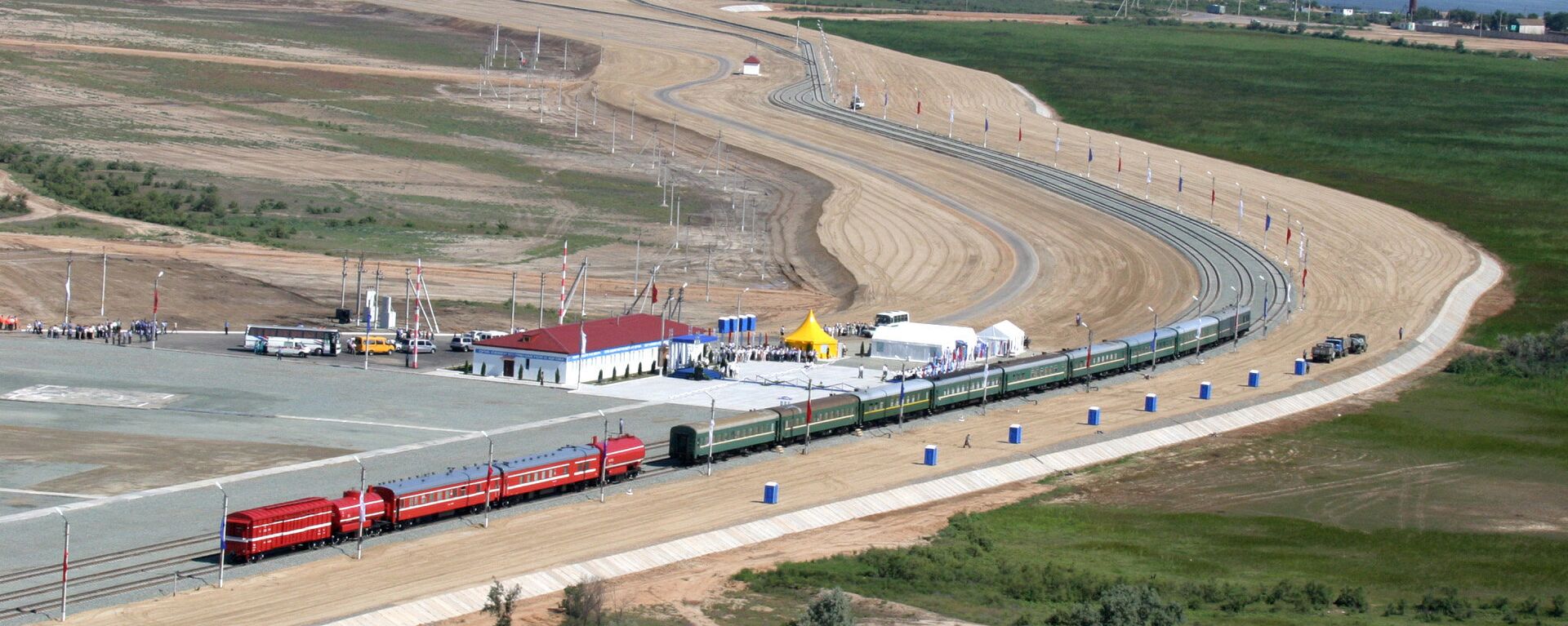https://sputniknews.in/20240514/chabahar-port-emerges-as-key-commercial-hub-in-south-asia-7359482.html
Chabahar Port Emerges as Key Commercial Hub in South Asia
Chabahar Port Emerges as Key Commercial Hub in South Asia
Sputnik India
India signed a long-term agreement with Iran on Monday to enhance and oversee operations at the Iranian port of Chabahar, thereby bolstering ties with this strategically significant Middle Eastern country.
2024-05-14T15:51+0530
2024-05-14T15:51+0530
2024-05-14T15:51+0530
s. jaishankar
india
iran
chabahar port
sputnik opinion
us
economics
economic challenges
indian economy
international north-south transport corridor (instc)
https://cdn1.img.sputniknews.in/img/07e8/05/0d/7355923_0:160:3072:1888_1920x0_80_0_0_5b6969b93fc6a50619e1eb1df3f3581f.jpg
India signed a long-term agreement with Iran on Monday to enhance and oversee operations at the Iranian port of Chabahar, thereby bolstering ties with this strategically significant Middle Eastern country.The signing of the contract, according to the Indian ministry, “will have a multiplier effect on the viability and visibility of Chabahar port”.The agreement entails an investment of approximately $120 million from IPGL, supplemented by an additional $250 million in financing, thus elevating the contract's total worth to $370 million, according to Iranian Minister of Roads and Urban Development Mehrdad Bazrpash.Strategic Significance of Chabahar Port Agreement Amid Global Geopolitical Turmoil “Chabahar was envisioned as integral to the International North-South Transport Corridor (INSTC), providing India with an alternative trade route. The recent agreement is a promising development, offering India additional avenues amidst geopolitical complexities, including those in the Gaza Strip”, Commodore R S Vasan (retd.), director general of the Chennai Centre of China Studies told, Sputnik India.The Indian Ministry of Ports and Shipping mentioned that “Chabahar is not only the closest Iranian port to India, but it is also an excellent port from a nautical point of view”.Chabahar Port, Agnihotri highlighted, “is Iran’s only oceanic port and comprises two terminals – of which India seeks to operate Shahid Beheshti Terminal. The port is also part of, and the key to the proposed INSTC – a multi-modal transportation project linking the Indian Ocean and the Persian Gulf to the Caspian Sea via Iran, and onward to Northern Europe via St. Petersburg in Russia”.“As a significant emerging economy with a robust global presence, India's connectivity to Central Asian republics, Asia, and Europe holds immense importance, especially amid the booming trade landscape”, he explained.Fostering Confidence: Indian Investment in Iran's Maritime Sector“INSTC is already in place and Chabahar Port is nearly operational, serving as a pivotal element to broaden its global infrastructure and developmental influence in line with its increasing global prominence”, Vasan added.However, he argued that “challenges persist, particularly with America's ongoing imposition of sanctions on Iran, which may affect operations to some extent, although not significantly. Moreover, Pakistan, as a significant stakeholder in Chabahar Port, has its vested interests to consider. Iran is keen to safeguard its economic interests amidst these complexities”.Vasan advised that “while this transformation will take time, it's foreseeable that more ships, operated by private companies, may opt for routes through Iran to minimise transportation costs”.Strategic Collaboration in Transportation: Balancing Investment and ConnectivityThis investment, Vasan indicated, “in a critical sector holds significant promise for both private and government operators in India. Recognising the cost efficiency of utilising shipping lanes or maritime routes, especially considering Chabahar's proximity to major trade hubs such as Mumbai and Gujarat on the west coast, underscores the significance of investments in this sector”.As a result, there will be a balanced approach, as per the commodore, “with approximately 70% of cargo being transported via sea routes and the remaining 30% via road and rail”.Similarly, “this diversification of transportation modes not only benefits coastal regions but also land-locked countries (recognised as per the provisions of UNCLOS) such as Nepal and Bhutan, which can now access sea routes, enhancing connectivity and trade opportunities for all parties involved in the INSTC and Chabahar Port initiatives”, he emphasised.
https://sputniknews.in/20240502/russian-railways-organises-agroexpress-from-the-urals-to-india-via-north-south-itc-7273472.html
india
iran
chabahar port
us
Sputnik India
feedback.hindi@sputniknews.com
+74956456601
MIA „Rossiya Segodnya“
2024
Swapna Nair
https://cdn1.img.sputniknews.in/img/07e7/09/12/4320104_0:0:681:681_100x100_80_0_0_ca8a7d4d582609272840ffdd1cde7278.jpg
Swapna Nair
https://cdn1.img.sputniknews.in/img/07e7/09/12/4320104_0:0:681:681_100x100_80_0_0_ca8a7d4d582609272840ffdd1cde7278.jpg
News
en_IN
Sputnik India
feedback.hindi@sputniknews.com
+74956456601
MIA „Rossiya Segodnya“
Sputnik India
feedback.hindi@sputniknews.com
+74956456601
MIA „Rossiya Segodnya“
Swapna Nair
https://cdn1.img.sputniknews.in/img/07e7/09/12/4320104_0:0:681:681_100x100_80_0_0_ca8a7d4d582609272840ffdd1cde7278.jpg
india, iran, iranian port of chabahar thereby, middle eastern, indian minister of ports and shipping, sarbananda sonowal, shahid beheshti port, chabahar, between india ports global ltd. & ports and maritime organisation of iran”, indian ministry of ports and shipping highlighted on x (former twitter)chabahar port, strategic importance to india, afghanistan, central asia, eurasian region, chabahar port, pgl, indian external affairs minister, jaishankar, iranian’s foreign minister h. amirabdollahian, instc, india, gaza strip” commodore r s vasan (retd), director general of the chennai centre of china studies, deep-sea access, afghanistan, pakistan, and india, afghanistan, international trade, captain kamlesh k agnihotri (retd), senior fellow, national maritime foundation, shahid beheshti terminal, international north-south transport corridor (instc), indian ocean and the persian gulf to the caspian sea via iran, and onward to northern europe via st. petersburg in russia, imec, gaza strip, red sea, cost-cutting measures, cape of good hope, maritime trade, transportation technology, connectivity, and overcoming weather-related obstacles
india, iran, iranian port of chabahar thereby, middle eastern, indian minister of ports and shipping, sarbananda sonowal, shahid beheshti port, chabahar, between india ports global ltd. & ports and maritime organisation of iran”, indian ministry of ports and shipping highlighted on x (former twitter)chabahar port, strategic importance to india, afghanistan, central asia, eurasian region, chabahar port, pgl, indian external affairs minister, jaishankar, iranian’s foreign minister h. amirabdollahian, instc, india, gaza strip” commodore r s vasan (retd), director general of the chennai centre of china studies, deep-sea access, afghanistan, pakistan, and india, afghanistan, international trade, captain kamlesh k agnihotri (retd), senior fellow, national maritime foundation, shahid beheshti terminal, international north-south transport corridor (instc), indian ocean and the persian gulf to the caspian sea via iran, and onward to northern europe via st. petersburg in russia, imec, gaza strip, red sea, cost-cutting measures, cape of good hope, maritime trade, transportation technology, connectivity, and overcoming weather-related obstacles
Chabahar Port Emerges as Key Commercial Hub in South Asia
India's investment in Chabahar benefits both private and government operators, given its proximity to major trade hubs like Mumbai and Gujarat, highlighting the cost efficiency of utilising shipping lanes, according to experts.
India signed a long-term agreement with Iran on Monday to enhance and oversee operations at the Iranian port of Chabahar, thereby bolstering ties with this strategically significant Middle Eastern country.
The Indian minister of ports and shipping, Sarbananda Sonowal, “witnessed the signing of the long-term contract for the operation of the Shahid Beheshti Port in Chabahar, between India Ports Global Ltd. & Ports and Maritime organisation of Iran”, India's Ports and Shipping Ministry highlighted on X (former Twitter).
Chabahar Port is of immense strategic importance to India, serving as a vital conduit linking the nation to Afghanistan, Central Asia, and the wider Eurasian region.
The signing of the contract, according to the Indian ministry, “will have a multiplier effect on the viability and visibility of Chabahar port”.
The agreement entails an investment of approximately $120 million from IPGL, supplemented by an additional $250 million in financing, thus elevating the contract's total worth to $370 million, according to Iranian Minister of Roads and Urban Development Mehrdad Bazrpash.
“Handed over the letter from Indian External Affairs Minister, Jaishankar to Iranian’s Foreign Minister H. Amirabdollahian, offering an INR credit window equivalent of USD 250 million for Chabahar-related development. Reiterated India’s commitment to cooperate with Iran in developing the Chabahar Port”, the Indian ministry noted.
Strategic Significance of Chabahar Port Agreement Amid Global Geopolitical Turmoil
“Chabahar was envisioned as integral to the
International North-South Transport Corridor (INSTC), providing India with an alternative trade route. The recent agreement is a promising development, offering India additional avenues amidst geopolitical complexities, including those in the Gaza Strip”, Commodore
R S Vasan (retd.), director general of the Chennai Centre of China Studies told,
Sputnik India.
The Indian Ministry of Ports and Shipping mentioned that “Chabahar is not only the closest Iranian port to India, but it is also an excellent port from a nautical point of view”.
“Chabahar’s unique attributes, including its deep-sea access and proximity to Afghanistan, Pakistan, and India, position it as a potential commercial hub in the region. Given Afghanistan's landlocked status and historical reliance on Pakistani ports for international trade, Chabahar presents India with an alternative route to bolster trade with Afghanistan”, Captain Kamlesh K Agnihotri (retd.), senior fellow, National Maritime Foundation, told Sputnik India.
Chabahar Port, Agnihotri highlighted, “is Iran’s only oceanic port and comprises two terminals – of which India seeks to operate Shahid Beheshti Terminal. The port is also part of, and the key to the proposed INSTC –
a multi-modal transportation project linking the Indian Ocean and the Persian Gulf to the Caspian Sea via Iran, and onward to Northern Europe via St. Petersburg in Russia”.
Considering the India-Middle East-Europe Economic Corridor (IMEC), according to Vasan, “facing setbacks due to unfolding events in the Gaza Strip and ongoing tensions in the Red Sea. Given these challenges, it's prudent for India to maintain flexibility and explore diverse connectivity avenues”.
“As a significant emerging economy with a robust global presence, India's connectivity to Central Asian republics, Asia, and Europe holds immense importance, especially amid the booming trade landscape”, he explained.
Fostering Confidence: Indian Investment in Iran's Maritime Sector
“INSTC is already in place and
Chabahar Port is nearly operational, serving as a pivotal element to broaden its global infrastructure and developmental influence in line with its increasing global prominence”, Vasan added.
However, he argued that “challenges persist, particularly with America's ongoing imposition of sanctions on Iran, which may affect operations to some extent, although not significantly. Moreover, Pakistan, as a significant stakeholder in Chabahar Port, has its vested interests to consider. Iran is keen to safeguard its economic interests amidst these complexities”.
“This initiative will enhance the confidence of Indian companies to invest in Iran, aligning with the strategic dimension integrated with the nation's economic advancement. The maritime sector has witnessed remarkable growth, instilling greater trust in port development, connectivity enhancement, and capacity augmentation”, the commodore mentioned.
Vasan advised that “while this transformation will take time, it's foreseeable that more ships, operated by private companies, may opt for routes through Iran to minimise transportation costs”.
Strategic Collaboration in Transportation: Balancing Investment and Connectivity
“Merchants prioritise cost-cutting measures, particularly amid rising insurance costs and extended voyages around the Cape of Good Hope due to incidents in the Red Sea. Therefore, as alternate channels become operational over the next five to 10 years, reliance solely on the Red Sea will diminish, bolstering confidence in maritime trade”, the expert underlined.
This investment, Vasan indicated, “in a critical sector holds significant promise for both private and government operators in India. Recognising the cost efficiency of utilising shipping lanes or maritime routes, especially considering Chabahar's proximity to major trade hubs such as Mumbai and Gujarat on the west coast, underscores the significance of investments in this sector”.
“While there is competition among investors, there's also a mutual understanding that these hubs, particularly Chabahar, will play a pivotal role in transportation and trans-shipment activities. This will further bolster the growth of major transportation corridors such as the INSTC, which will witness advancements in road transportation technology, connectivity, and overcoming weather-related obstacles”, Vasan said.
As a result, there will be a balanced approach, as per the commodore, “with approximately 70% of cargo being transported via sea routes and the remaining 30% via road and rail”.
Similarly, “this diversification of transportation modes not only benefits coastal regions but also land-locked countries (recognised as per the provisions of UNCLOS) such as Nepal and Bhutan, which can now
access sea routes, enhancing connectivity and trade opportunities for all parties involved in the INSTC and Chabahar Port initiatives”, he emphasised.



